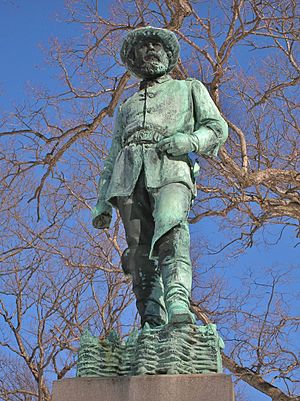John Lyman Chatfield facts for kids
Quick facts for kids
John Lyman Chatfield
|
|
|---|---|
| Born | September 13, 1826 Oxford, Connecticut, US |
| Died | August 9, 1863 (aged 36) Waterbury, Connecticut, US |
| Allegiance | Union |
| Service/ |
|
| Rank | |
| Commands held | |
| Battles/wars | American Civil War |
John Lyman Chatfield was an important soldier during the American Civil War. He was a colonel in the Union Army. Colonel Chatfield was badly hurt during a battle at Fort Wagner in South Carolina. He passed away a few weeks later in August 1863.
Contents
Growing Up
John Lyman Chatfield was born on September 13, 1826. His hometown was Oxford, Connecticut. In 1851, he moved to Waterbury, Connecticut. He went there with his brothers. John joined the City Guard in 1854. He quickly became a first lieutenant.
A Soldier's Journey
When President Lincoln asked for soldiers, Chatfield and his company signed up. They left for New Haven on April 20, 1861. His company was the first one accepted by the Governor.
Chatfield became a major on April 23, 1861. This was for the 1st Regiment Connecticut Volunteer Infantry. He was then promoted to lieutenant colonel on May 10, 1861. On May 31, 1861, Chatfield became a colonel of the 3rd Regiment Connecticut Volunteer Infantry. He finished his service with these volunteers on August 12, 1861.
On September 13, 1861, Chatfield was again made a colonel. This time, he led the 6th Regiment Connecticut Volunteer Infantry. From April to July 1862, Colonel Chatfield led the 1st Brigade. This group was part of the Union Department of the South. In October 1862, he was in charge of the area around Beaufort, South Carolina. He worked under Major General Ormsby M. Mitchel.
The Battle of Pocotaligo
On October 21, 1862, Major General Mitchel planned a mission. The goal was to destroy parts of the Charleston and Savannah Railway. This railway was in Jasper County, South Carolina. Mitchel gave command of this mission to Brigadier General John Milton Brannan. Sadly, General Mitchel was sick with yellow fever. He passed away soon after.
General Brannan then gave command of the First Brigade to Colonel Chatfield. This brigade fought hard in the Battle of Pocotaligo. This battle happened on October 22, 1862. During the fight, Colonel Chatfield was hurt. An artillery shell hit his right thigh.
The Attack on Fort Wagner
On July 18, 1863, Brigadier General George Crockett Strong ordered an attack. Colonel Chatfield was part of this attack. They were to storm Fort Wagner. This fort was on Morris Island, South Carolina. It was south of the harbor at Charleston, South Carolina.
Colonel Chatfield bravely led his soldiers in the attack. He was at the front of his men. During this fierce battle, he was badly wounded. He was taken out of the fight. Then, he was sent back home to Connecticut.
His Final Days and Legacy
Colonel Chatfield passed away on August 9, 1863. He died in Waterbury, Connecticut. The wounds he received at Fort Wagner developed an infection called gangrene. He was buried at Riverside Cemetery. Many important people attended his funeral. These included General Robert Anderson, who defended Fort Sumter. The Governor of Connecticut, William Alfred Buckingham, was also there.
On September 13, 1887, a special statue was unveiled. It was placed at Riverside Cemetery to honor him. The statue was made of bronze and was life-size. It was designed by George Edwin Bissell. The statue stood on a seven-foot granite base. Members of the Sixth regiment and the First Light battery attended the ceremony. General Stephen Wright Kellogg gave a speech. He spoke about Chatfield's courage and his love for his country.


